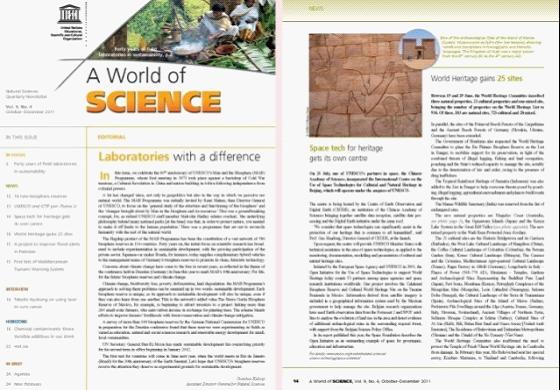Recently, A World of SCIENCE, Vol. 9, No. 4, October–December 2011,
issued by the United Nations Educational, Scientific, and Cultural Organization
(UNESCO), published an article entitled Space Tech for Heritage Gets Its Own
Centre to introduce the International Centre on Space Technologies for Natural
and Cultural Heritage (HIST) hosted by the Aerospace Information Research Institute (AIR) of CAS. Now, the full text is as follows: (Note: the
“date of foundation” and the “name of the Center” in the original are
incorrect. The date should be 24 July, 2011; the name should be International
Centre on Space Technologies for Natural and Cultural Heritage).
On 24 July, one of UNESCO’s partners in space, the Chinese Academy
of Sciences, inaugurated the International Centre on the Use of Space
Technologies for Cultural and Natural Heritage in Beijing, which will operate
under the auspices of UNESCO.
The centre is being hosted by the Aerospace Information Research Institute (AIR), an institution of the Chinese Academy of Sciences
bringing together satellite data reception, satellite date processing and the
Digital Earth initiative under the same roof.
‘We consider that space technologies can significantly assist in the
protection of our heritage that is common to all humankind’, said Prof. Guo
Huadong, Director-General of AIR, at the launch.
Upon request, the centre will provide UNESCO Member States with
technical assistance in the area of space technologies, as applied to the
monitoring, documentation, modelling and presentation of cultural and natural
heritage sites.
Initiated by the European Space Agency and UNESCO in 2001, the Open
Initiative for the Use of Space Technologies to support World Heritage today
counts 53 partners among space agencies and space research institutions
worldwide. One project involves the Calakmul Biosphere Reserve and Cultural
World Heritage Site on the Yucatan Peninsula in Mexico. Information derived
from satellite imagery is included in a geographical information system used by
the Mexican government to help manage the site. Belgian research organizations
have used Earth observation data from the Formosat 2 and SPOT satellites to
analyse the evolution of land use in the area and detect evidence of additional
archaeological ruins in the surrounding tropical forest, with support from the
Belgian Science Policy Office.
In its report published this year, the Space Foundation describes
the Open Initiative as an outstanding example of space for governance,
education and infrastructure.

